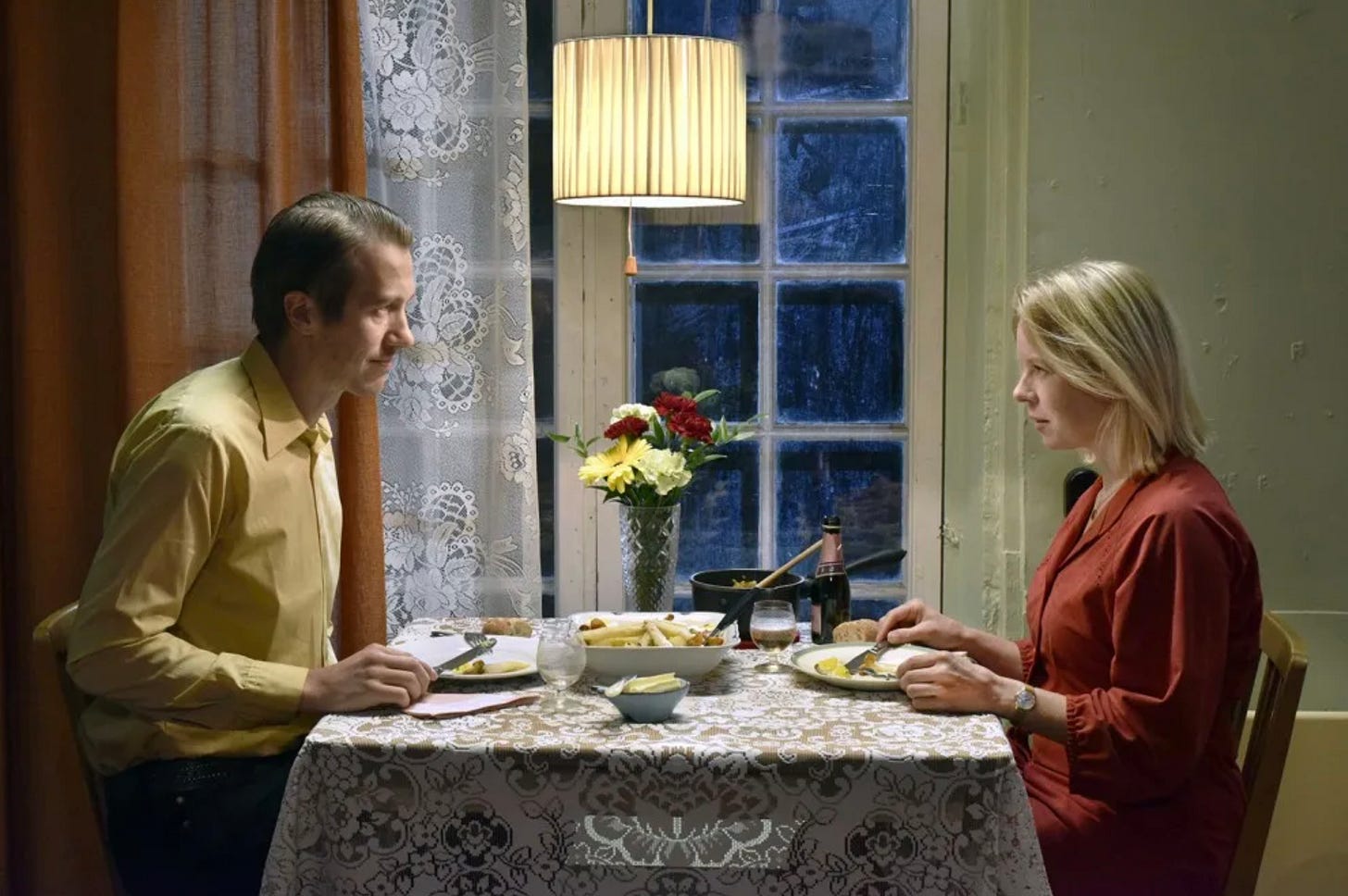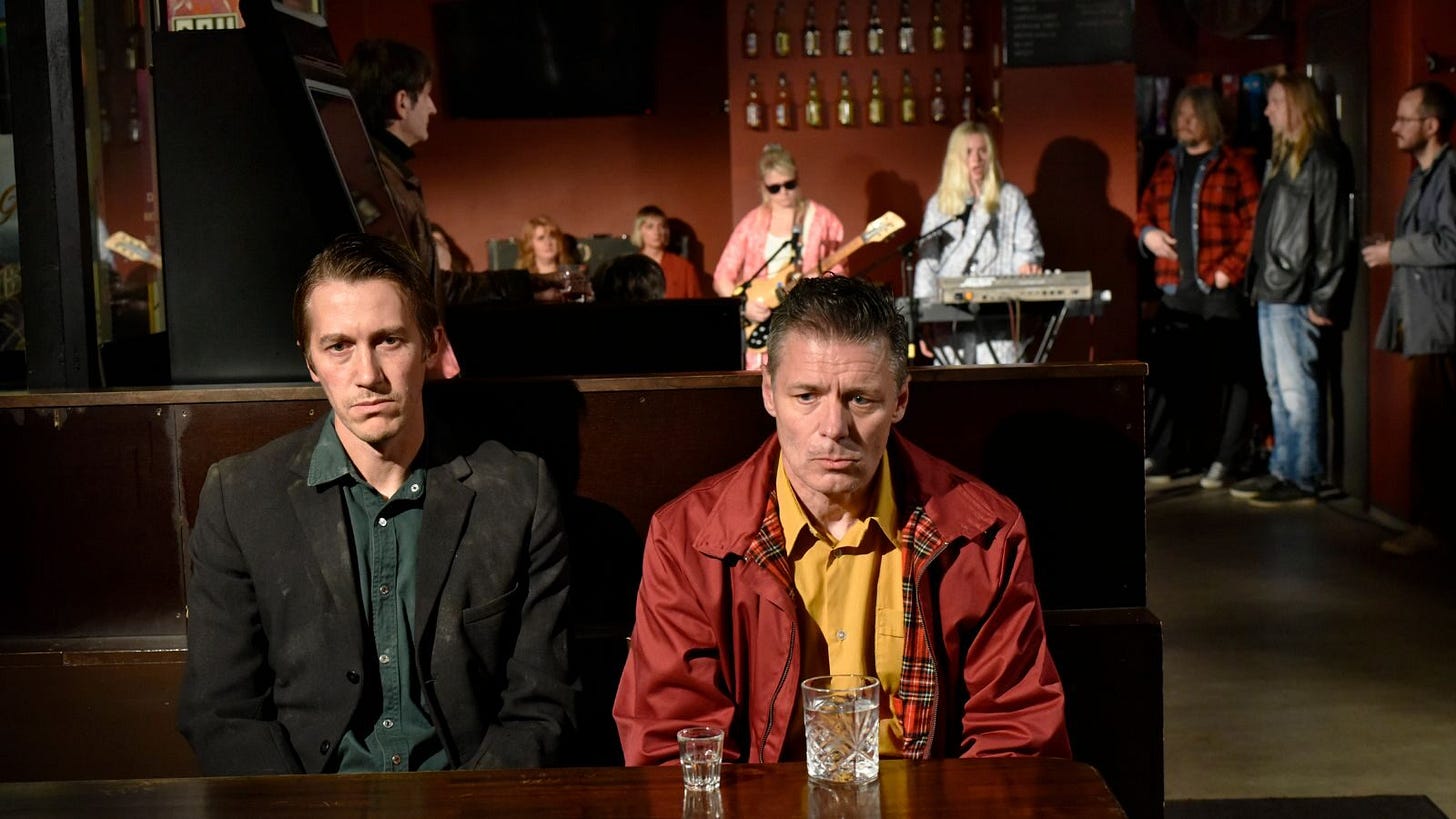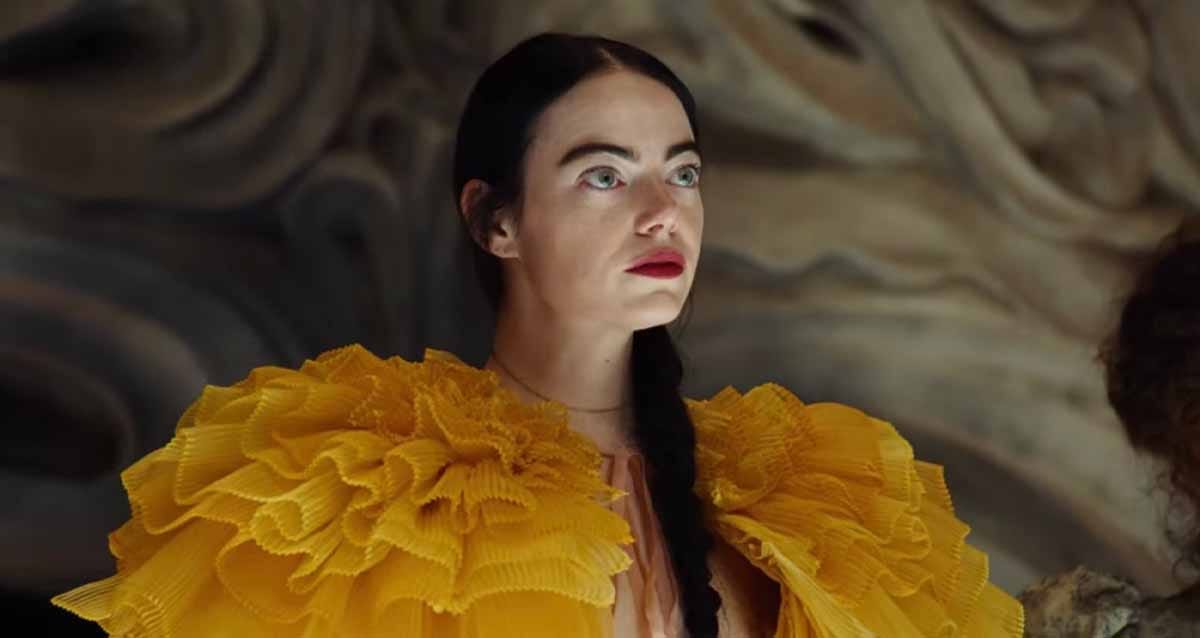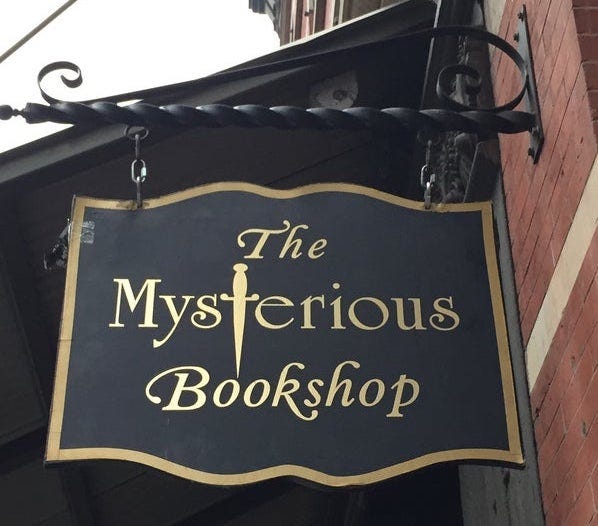Issue 35: Other People
Aki Kaurismäki, the Ian Curtis office party, families on film, auto-didacts and more
Aki Kaurismäki’s Fallen Leaves is best summed up by John Waters in his list of favourite movies from 2023 for Vulture: “An alcoholic factory worker and a lonely supermarket clerk meet by chance and struggle to fall in love. It’s drab, it’s short, it’s beautiful, and it lacks nothing. Just call it Unmagnificent Obsession.”
Kaurismäki has perfected drab, short, beautiful, and lacks nothing across forty-plus years of bittersweet and luminous cinema. “Luminous” because his films glow with empathy and romantic longing despite largely taking place in the same cold blue Finnish dark. Someone once said that if you watch Tokyo Story by Yasujirō Ozu—the great Japanese director is a major influence on Kaurismäki—you will immediately afterwards want to phone your parents to tell them that you love them. Watching Kaurismäki will make you want to put on a sweater and turn up the heating.
He strands his characters outside of time, in a perpetual 1970s peopled with deflated working-class men and women who idolize 1950s Americana. They drink heavily and live in sparsely furnished apartments. They’re exploited at work, they lose their jobs, go to awkward dances and fail to speak to anyone they like. They dream of escaping elsewhere. Their stories are surprisingly uplifting. Perhaps his best-known film is Leningrad Cowboys Go America, a comedy made in 1989 about a struggling band from the Siberian tundra, the Leningrad Cowboys, who travel to the USA in search of fame. But if you want an introduction to pure, distilled Kaurismäki, try Take Care of Your Scarf, Tatiana, from 1994. Only an hour long, it’s a simple road movie in which two shy, awkward men give two shy, awkward women a lift to catch a ferry to Estonia. Kaurismäki crafts this into a tender, funny, and gorgeously-shot story about love, ambition, masculinity, cars, coffee, Europe and America, and men and their mothers. Drab, short, beautiful, lacks nothing.
Fallen Leaves brushes only lightly against our present. Ansa, the supermarket clerk, uses a mobile phone and worries over radio reports from the war in Ukraine. Holappa, her love interest, regularly and reluctantly goes to karaoke. The pair go on a date to see a Jim Jarmusch movie. (Jarmusch and Kaurismäki are old friends.) Yet the film looks exactly like one of Kaurismäki’s works from forty years ago, the clothes, sets, music, all unchanged. You sense that Ansa’s anxiety about Ukraine channels Finland’s long and tense history with Russia more than the current conflict. Her local cinema has posters advertising only old movies.
For all the loss and loneliness he puts his characters through, Kaurismäki refuses to objectify working-class life as unmitigated misery or paint it with patronizing shades of earthy wisdom. His characters’ lives are complex. They endure shit and shine. They’re often exhausted or put-upon, they work hard, deal with poverty, isolation and alcoholism, but small pleasures often take on enormous significance in their lives, anchoring each of them to something that provides self-esteem and hope.
In Fallen Leaves, there is a scene in which Ansa is fired from her zero-hours supermarket job having been caught giving food to a homeless man, then taking an expired microwave meal home in her handbag. Kaurismäki keeps the scene concise. He doesn’t drag out Ansa’s humiliation or spell out the injustice of the situation. Instead he pricks the pomposity of her jobsworth boss and the security guard who dobbed her in. Their absurd cruelty is contrasted with Ansa’s quiet dignity, yet the scene doesn’t feel like an earnest lecture about “quiet dignity.” She returns home to find a huge electricity bill. Her reaction is to unplug every appliance and turn off the lights. The next day she gets a job washing dishes. It’s sad, it’s hard-nosed, it’s also funny.
Kaurismäki and his ensemble should be given a lifetime achievement award for deadpan. Nobody does a hangdog expression better than a Kaurismäki actor. In one scene in Fallen Leaves, a man gets up to perform a mournful Schubert liede at a karaoke bar. It’s set up to make your toes curl. As he begins to sing, Kaurismäki wants you to wonder why the man can’t see how this will only lead to mockery, to loneliness, into the dangerous consolations of drink. And then he shows the bar patrons rapt by the man’s performance. It’s a simple flip— obvious, almost— pulled off with perfect comic timing. What did you expect to happen, Kaurismäki seems to ask, why did you assume the people in this bar wouldn’t appreciate Schubert?
Empathy is a business that some artists choose to conduct using a long-range telephoto lens. Like every optical tool, it creates distortions. These artists talk a big game about “being political,” consider their own art to be an act of service to others while only serving themselves, but find it difficult to talk to anyone from outside their professional circles. Every December I notice the same photograph doing the rounds of Instagram. It shows the Joy Division singer Ian Curtis at an office Christmas party with his colleagues at the Macclesfield Unemployment Office. The joke, I guess, is to imagine that he had a few mince pies that night then went home and wrote Love Will Tear Us Apart. It’s a comedy of contrasts, amusing in the same way that it’s amusing to know that Rod Stewart is a keen model railway enthusiast and that Penelope Cruz allegedly collects coat hangers. (Google it.) But it is mostly an ordinary image, the same as any other office Christmas party snap. I wonder why the photo circulates. Maybe it’s because the idea that a troubled man who sang anthems of existential despair could also be a person who has a laugh at a party confuses those who believe an artist’s personality must exist in a 1:1 ratio with their work. Or, more disturbingly, what people find funny is that he could’ve had anything in common with his colleagues. The assumption is that Schubert was not on the pub jukebox that night. He probably wasn’t. That doesn’t mean he wasn’t there in spirit, singing along to Slade’s Merry Christmas Everybody in a beautiful counter-tenor.
In ‘Difficult and Bad’, a recent essay for Too Little/Too Hard, Rachael Allen analyses this species of assumption with lucidity and force. She describes her eighty-year-old father—a cleaner who has also worked as a farmer, bread van driver, shop worker, shop manager, and gardener—and his life-long dedication to learning. “He gives himself a summer to read War and Peace, and then all the books around Tolstoy and Russian literature he can find. When I was younger, he read books to my sister and I every night. I grew up with him pointing out flowers, leaves, and trees, in Latin, that he’d taught himself over years as an amateur naturalist, botanist, ornithologist.” Allen talks about her migration from a working-class upbringing into the middle-class publishing industry, which she found riddled with the rot of anti-intellectualism and an institutionalized snobbery towards an illusory “general audience” who are imagined to be unwilling or unable stretch their minds. “I find many mainstream popular accounts of working-class life difficult to relate to, or unrealistic, because of the paradox that exists in my father. A working-class man, born to farmers, deprived of any significant or structured education, who has educated himself independently for no other reason than a deep-seated curiosity and desire to learn.”
A few weeks ago my mum (hi mum!—she’s reading this) told me that one evening she was at home watching a documentary on the TV about rural poverty in Britain. An archive clip came on the screen. Something appeared familiar. It took her a moment before she suddenly realized that she was looking at her parents—my nain and taid (grandma and grandad in Welsh, sounds a bit like ‘nine’ and ‘tied’)—walking along the path to their remote home in the North Wales mountains. This was followed by a shot of the family sat around the kitchen table. My taid was a shepherd, and my nain—whose parents died when she was small, and who had to go into service at the age of fourteen—was responsible for raising the family and all the other jobs demanded of a farmer’s wife. Nine of them, my mum being the eldest and a deputized mother to her siblings, lived in a small stone cottage with no electricity on the side of a mountain, miles from the nearest village. You can now rent it for £500 a night from the National Trust. It offers “heaps of Welsh charm,” they say. It sleeps four.
The funny thing about the TV documentary, my mum said to me, was that “we knew we didn’t have money but we didn’t think we lived in “rural poverty”.” The family defined themselves by the work they did, by the people they knew, by chapel and the Welsh language. Literacy and education were highly regarded in the family. My mum passed the exams that got her into grammar school but, like Allen’s father, she did not have the opportunity to go to university. She grew up bilingual, first speaking Welsh, then learning English as her second language around the age of ten. “My mother always complained that I always had my nose in a book,” she tells me. Before my parents met, before I came along, she had spent years working hard, against enormous odds, as a single mother raising my two older brothers. Through everything she has maintained a life-long curiosity about literature and the arts, which she has passed on to all her children, along with a profound respect for the natural world. When I was a teenager the two of us would go regularly to the local theatre to see plays. She encouraged me to read, to make art and to play music. Now in her eighties, that enthusiasm is undimmed. Often the conversation turns to books that she’s seen reviewed in the paper and caught her interest. An avid radio listener, she recommends programmes she’s heard and thinks I might like. We talk about exhibitions and films. My mum possesses none of the complacency about knowledge shown by some people I have met who have degrees.
One of my aunts discovered the above clip on YouTube a couple of years ago. Posted by British Pathé, it is titled “Sheep Shearing (1960-1970)” and captioned “Location Unknown/Unclear.” It’s colour, shot in warm weather judging by the short sleeves and bare feet, and it shows a group of men shearing sheep in a mountain valley. About fifty-three seconds in, you can see a man in a white shirt and flat cap standing at a wooden gate, holding a sheep by the scruff of its neck. He appears again, at one-minute twenty-four, in a close-up. That’s my taid. The location is near Capel Curig in North Wales. My mum and aunt believe that a number of the men in the clip were Australian farmers, visiting on an exchange programme. It’s instructive to read about the anthropologist’s gaze in theory books about film and photography, even more so to see someone you knew as a living, breathing person turned into a subject by the camera, rendered anonymous, “location unknown.” His representation is subordinated to the purpose of the film. If only you were able to climb into the film clip, to introduce yourself to this man in a flat cap, follow him home, sit at his kitchen table and talk over a cup of tea, you would discover a family, a personality, beliefs and opinions, expertise, a life led in another language.
But as W.H. Auden says in his poem ‘Musée des Beaux Arts,’ what is of great importance to one person always takes place “While someone else is eating or opening a window or just walking dully along.” No matter how enthusiastically I try and write about it, the Pathé YouTube clip remains something of an abstraction for you, the reader. When I think about the billions of images of other people that exist, I think about how we know so little of the lives captured in them. An interesting exercise is to make a list of those aspects of your own life which would never reach the surface, would be impossible to depict for whatever reasons—practical, personal—if someone tried to make a film about you. It’s difficult to do because we are often invisible to ourselves. This is certainly true for artists and writers. The course all arts careers take passes constantly through landscapes of visibility and invisibility. (Professionally speaking, artistic fame is a record of those who didn’t make it as well as those who did, and if you want to be successful, never be the first to do something: the unfamiliar is an all-too effective invisibility cloak.) An artist or writer’s work always exists for its maker in perpetual half-shadow, partially obscured to them by time and temperament, partially hidden by what other people want to describe it as. You might think you’re writing about your family, the world says you’re writing about rural poverty.
A criticism I’ve heard about Yorgos Lanthimos’s recent movie Poor Things is that it relocates the story away from Glasgow, where Alasdair Gray’s original novel is set. Watching the film in New York City, I wondered how much that mattered. It was an act of interpretation not fidelity. The book and the film can co-exist. Yet for Gray it was vitally important to depict his beloved Glasgow in his work. The writer Liz Lochhead said that Gray “created his own Glasgow for himself to live in.” It was a matter of pride. To capture it in prose, in his paintings and murals, was a way to defy dismal typologies of the city as run-down, gloomy and tough, and instead to elevate its culture and its intellectual life.
There is a famous scene in his magnum opus, Lanark, in which art students Duncan Thaw and Kenneth McAlpin are on a hillside looking across the city. McAlpin asks his friend why nobody notices how magnificent Glasgow appears. “Because nobody imagines living here,” says Thaw:
‘“Then think of Florence, Paris, London, New York. Nobody visiting them for the first time is a stranger because he’s already visited them in paintings, novels, history books and films, But if a city hasn’t been used by an artist not even the inhabitants live there imaginatively. What is Glasgow to most of us? A house, the place we work, a football park or golf course, some pubs and connecting streets. That’s all. No, I’m wrong, there’s also the cinema and library, and when our imagination needs exercise we use these to visit London, Paris, Rome under the Caesars, the American West at the turn of the century, anywhere but here and now.”
[…]
After a moment, McAlpin said, “So you paint to give Glasgow a more imaginative life.”
“No, that’s my excuse. I paint because I feel cheap and purposeless when I don’t.”
“I envy your purpose.”
“I envy your self-confidence.”’
Lanark shifts between the story of Thaw, an aspiring artist living in mid-century Glasgow, and his alter-ego, Lanark, trapped in a nightmarish shadow version of the city named Unthank. It hit me like a meteor from space when I first read it. I loved the novel for its imaginative scope and for Gray’s clear, vivid prose, stacked with literary allusions. I liked its mess: the book has an odd structure, and if you can imagine William Blake doing stand-up, it’s funny too, willing to indulge a throwaway gag on one page, then sombre and frightening on the next.

The novel showed me other things too. I discovered Gray’s painting and drawing, and fell for his unique use of line and colour. I was drawn to the model of Gray as an autodidact, and admired the way he moved easily between painting, design, and writing: it gave me permission, in a way, to reconcile parts of my creative life which pulled in opposing directions. Then there was the way he made his politics part of his art through doing rather than talking it up, by painting murals in buildings and homes across the city, by making portraits of local people he knew, designing posters, contributing to its cultural life socially, winding the city into his stories. He did not use a long-range telescopic lens.
Lanark took decades to see the light of day. It’s one reason why the story has such a peculiar atmosphere and structure. Gray began writing it in the 1950s. It wasn’t finished until 1976, and wasn’t published until 1981. The passage quoted above is taken from a section completed in the early 1960s, which was rejected when Gray first tried to get it published. Imagine starting to write a book in the late 1990s and completing it this year. Now think of everything that has happened in the world, and happened to you personally, inbetween. The novel is a monument to patience and to the evolution of an artist’s sensibility.
At meal times, my nain used to call taid in from tending the sheep by blowing a conch shell, like a horn. My tiny nain, five-foot-nothing, making a sound that reverberated across the valley from their house like a bugle from the heavens. If you could translate the sound into words it would have said: “make yourself seen, come home, eat, tell us what you’ve done today, and we’ll tell you the same, in all our complexity and love. Also, there’s a camera crew here and Schubert might join us for pudding.”
RECOMMENDATIONS
—I’ve been enjoying this new arrangement of Moondog’s Theme by Kronos Quartet and Ghost Train Orchestra. It’s taken from the album Songs and Symphonies, a collection reinterpreting the work of Moondog, the blind composer who used to stand on New York’s Sixth Avenue dressed as a Viking. The album scrubs the music a little too clean for my money, but this version of Theme brings in an astonishing klezmer-like clarinet part halfway through, which is wild and incandescent and makes me want to practice my clarinet more.
—Critic Ben Davis has interviewed the legendary critic Lucy R. Lippard for The Art Angle podcast. If you haven’t already, seek out Lippard’s engrossing memoir, Stuff, which came out last year, an autobiography told through the objects in her house.
—I have recently embarked on a mission to visit all the specialist bookstores of New York. When I say specialist, I don’t mean the genre of used bookstore that will sell you an attitude and a tatty back issue of Interview magazine for $300 but won’t let you touch the poetry books. I mean specialist. My first destination was The Mysterious Bookshop on Warren Street in TriBeCa. Opened in 1979, it’s the oldest crime and mystery bookshop in the world. (London used to have its own, called Murder One, which closed in 2009.) The decor is dark wood, the lighting moody. It’s like the library of a stately home in an Agatha Christie story. Somehow it is not gimmicky. The store has twenty-foot-high shelves packed with new and classic whodunits, noirs, spy novels and thrillers. They sell their own self-published line of ‘Bibliomysteries’—crime books about book crimes—and regularly publish anthologies of new writing in the genre. Each December they give away a specially commissioned holiday mystery story free with every purchase. On my visit I told the bookseller on duty that I’d read all of Raymond Chandler and two Dashiell Hammetts, but didn’t know where to go next. The clerk pointed me in the direction of a noir story anthology, and a stack of cheap secondhand pulp paperbacks in case I wanted a lucky dip. Friendly, helpful, zero attitude, abundant choice, and I bet they’d let you touch the poetry books if they had any. Five stars!









